Assessing the Microclimate Effects and Irrigation Water Requirements of Mesic, Oasis, and Xeric Landscapes
Abstract
:1. Introduction
2. Study Area
3. Methodology
3.1. ENVI-Met Overview
3.2. Model Setup
3.3. Model Evaluation
3.4. Determination of Microclimate Effects
3.5. Determination of Potential Irrigation Water Requirement
4. Results
4.1. Model Evaluation
4.2. Microclimate Effects of Landscapes
4.2.1. Variation in Surface Temperature
4.2.2. Spatial Variation in Wind Speed
4.2.3. Diurnal Variation in Air Temperature and Wind Speed
4.3. Potential Irrigation Water Requirement of Landscapes
5. Discussion
6. Conclusions
Author Contributions
Funding
Data Availability Statement
Acknowledgments
Conflicts of Interest
References
- Hilaire, R.S.; Arnold, M.A.; Wilkerson, D.C.; Devitt, D.A.; Hurd, B.H.; Lesikar, B.J.; Lohr, V.I.; Martin, C.A.; McDonald, G.V.; Morris, R.L.; et al. Efficient water use in residential urban landscapes. HortScience 2008, 43, 2081–2092. [Google Scholar] [CrossRef]
- Brelsford, C.; Abbott, J.K. How Smart Are ‘Water Smart Landscapes’? 2018, pp. 1–45. Available online: http://arxiv.org/abs/1803.04593 (accessed on 13 March 2018).
- Pincetl, S.; Gillespie, T.W.; Pataki, D.E.; Porse, E.; Jia, S.; Kidera, E.; Nobles, N.; Rodriguez, J.; Choi, D.A. Evaluating the effects of turf-replacement programs in Los Angeles. Landsc. Urban Plan. 2019, 185, 210–221. [Google Scholar] [CrossRef]
- Sovocool, K.A. Xeriscape Conversion Study Final Report by Area. 2005, p. 93. Available online: http://www.allianceforwaterefficiency.org/Xeriscape_Water_Savings.aspx (accessed on 10 April 2020).
- Fisher, J.B.; Whittaker, R.J.; Malhi, Y. ET come home: Potential evapotranspiration in geographical ecology. Glob. Ecol. Biogeogr. 2011, 20, 1–18. [Google Scholar] [CrossRef]
- OKE, T.R. The energetic basis of the urban heat island. Q. J. R. Meteorol. Soc. 1987, 16, 121–129. [Google Scholar] [CrossRef]
- Saher, R.; Ahmad, S.; Stephen, H. Analysis of changes in surface energy fluxes due to urbanization in Las Vegas. In Proceedings of the World Environmental and Water Resources Congress 2019: Groundwater, Sustainability, Hydro-Climate/Climate Change, and Environmental Engineering, Pittsburgh, PA, USA, 19–23 May 2019; American Society of Civil Engineers: Reston, VA, USA, 2019. [Google Scholar] [CrossRef]
- Wood, L.; Hooper, P.; Foster, S.; Bull, F. Public green spaces and positive mental health—Investigating the relationship between access, quantity and types of parks and mental wellbeing. Health Place 2017, 48, 63–71. [Google Scholar] [CrossRef] [PubMed]
- Saher, R.; Stephen, H.; Ahmad, S. Urban evapotranspiration of green spaces in arid regions through two established approaches: A review of key drivers, advancements, limitations, and potential opportunities. Urban Water J. 2020, 18, 1–13. [Google Scholar] [CrossRef]
- Smeal, D.; O’Neill, M.; Lombard, K.; Arnold, R. Crop Coefficients for Drip-Irrigated Xeriscapes and Urban Vegetable Gardens; NMSU Agricultural Science Center: Los Lunas, NM, USA, 2009; pp. 1–12. [Google Scholar]
- Kjelgren, R.; Rupp, L.; Kilgren, D. Water conservation in urban landscapes. HortScience 2000, 35, 1037–1040. [Google Scholar] [CrossRef] [Green Version]
- Chow, W.T.; Brazel, A.J. Assessing xeriscaping as a sustainable heat island mitigation approach for a desert city. Build. Environ. 2012, 47, 170–181. [Google Scholar] [CrossRef]
- Middel, A.; Chhetri, N.; Quay, R. Urban forestry and cool roofs: Assessment of heat mitigation strategies in Phoenix residential neighborhoods. Urban For. Urban Green. 2015, 14, 178–186. [Google Scholar] [CrossRef]
- Mitchell, D. Assessment of the Viability of Xeriscaping to Reduce Water Consumption in Sacramento. Unpublished work. 2014. [Google Scholar]
- Overview, W.V. Offsetting water conservation costs to achieve net-zero water use. J. Am. Water Work. Assoc. 2013, 105, 62–72. [Google Scholar] [CrossRef]
- Saher, R. Kaleidoscope of Urban Evapotranspiration: Exploring the Science and Modeling Approaches. Doctoral Dissertation, University of Nevada, Las Vegas, NV, USA, 2021. [Google Scholar]
- Nouri, H.; Beecham, S.; Kazemi, F.; Hassanli, A.M. A review of ET measurement techniques for estimating the water requirements of urban landscape vegetation. Urban Water J. 2013, 10, 247–259. [Google Scholar] [CrossRef]
- Saher, R.; Stephen, H.; Ahmad, S. Urban Climate “Urban Climate Effect of land use change on summertime surface temperature, albedo, and evapotranspiration in Las Vegas Valley”. Urban Clim. 2021, 39, 100966. [Google Scholar] [CrossRef]
- Saher, R.; Stephen, H.; Ahmad, S. Urban Climate Understanding the summertime warming in canyon and non-canyon surfaces. Urban Clim. 2021, 38, 100916. [Google Scholar] [CrossRef]
- Litvak, E.; Manago, K.F.; Hogue, T.S.; Pataki, D.E. Evapotranspiration of urban landscapes in Los Angeles, California at the municipal scale. Water Resour. Res. 2017, 53, 4236–4252. [Google Scholar] [CrossRef]
- Litvak, E.; Bijoor, N.S.; Pataki, D.E. Adding trees to irrigated turfgrass lawns may be a water-saving measure in semi-arid environments. Ecohydrology 2014, 7, 1314–1330. [Google Scholar] [CrossRef]
- Litvak, E.; Pataki, D.E. Evapotranspiration of urban lawns in a semi-arid environment: An in situ evaluation of microclimatic conditions and watering recommendations. J. Arid Environ. 2016, 134, 87–96. [Google Scholar] [CrossRef] [Green Version]
- Kusaka, H.; Kimura, F. Coupling a Single-Layer Urban Canopy Model with a Simple Atmospheric Model: Impact on Urban Heat Island Simulation for an Idealized Case. J. Meteorol. Soc. Japan 2004, 82, 67–80. [Google Scholar] [CrossRef] [Green Version]
- Chen, F.; Kusaka, H.; Bornstein, R.; Ching, J.; Grimmond, C.S.B.; Grossman-Clarke, S.; Loridan, T.; Manning, K.W.; Martilli, A.; Miao, S.; et al. The integrated WRF/urban modelling system: Development, evaluation, and applications to urban environmental problems. Int. J. Climatol. 2011, 31, 273–288. [Google Scholar] [CrossRef]
- Vahmani, P.; Hogue, T.S. Incorporating an Urban Irrigation Module into the Noah Land Surface Model Coupled with an Urban Canopy Model. J. Hydrometeorol. 2014, 15, 1440–1456. [Google Scholar] [CrossRef]
- Crank, P.J.; Middel, A.; Wagner, M.; Hoots, D.; Smith, M.; Brazel, A. Validation of seasonal mean radiant temperature simulations in hot arid urban climates. Sci. Total Environ. 2020, 749, 141392. [Google Scholar] [CrossRef]
- Middel, A.; Häb, K.; Brazel, A.J.; Martin, C.A.; Guhathakurta, S. Impact of urban form and design on mid-afternoon microclimate in Phoenix Local Climate Zones. Landsc. Urban Plan. 2014, 122, 16–28. [Google Scholar] [CrossRef]
- Vahmani, P.; Sun, F.; Hall, A.; Ban-Weiss, G. Investigating the climate impacts of urbanization and the potential for cool roofs to counter future climate change in Southern California. Environ. Res. Lett. 2016, 11, 124027. [Google Scholar] [CrossRef]
- Crank, P.J.; Sailor, D.J.; Ban-Weiss, G.; Taleghani, M. Evaluating the ENVI-met micro-scale model for suitability in analysis of targeted urban heat mitigation strategies. Urban Clim. 2018, 26, 188–197. [Google Scholar] [CrossRef]
- Kjelgren, R.; Beeson, R.C.; Pittenger, D.P.; Montague, T. Simplified landscape irrigation demand estimation: Slide rules. Appl. Eng. Agric. 2016, 32, 363–378. [Google Scholar] [CrossRef]
- Hoedjes, J.C.B.; Chehbouni, A.; Jacob, F.; Ezzahar, J.; Boulet, G. Deriving daily evapotranspiration from remotely sensed instantaneous evaporative fraction over olive orchard in semi-arid Morocco. J. Hydrol. 2008, 354, 53–64. [Google Scholar] [CrossRef] [Green Version]
- Volo, T.J.; Vivoni, E.R.; Ruddell, B.L. An ecohydrological approach to conserving urban water through optimized landscape irrigation schedules. Landsc. Urban Plan. 2015, 133, 127–132. [Google Scholar] [CrossRef]
- Litvak, E.; McCarthy, H.R.; Pataki, D.E. Transpiration sensitivity of urban trees in a semi-arid climate is constrained by xylem vulnerability to cavitation. Tree Physiol. 2012, 32, 373–388. [Google Scholar] [CrossRef] [Green Version]
- Litvak, E.; McCarthy, H.R.; Pataki, D.E. A method for estimating transpiration of irrigated urban trees in California. Landsc. Urban Plan. 2017, 158, 48–61. [Google Scholar] [CrossRef] [Green Version]
- Nouri, H. Evapotranspiration estimation in heterogeneous urban vegetation. Doctoral Dissertation, University of South Australia, Adelaide, Australia, 2014. [Google Scholar]
- Ambrosini, D.; Galli, G.; Mancini, B.; Nardi, I.; Sfarra, S. Evaluating mitigation effects of urban heat islands in a historical small center with the ENVI-Met® climate model. Sustainability 2014, 6, 7013–7029. [Google Scholar] [CrossRef] [Green Version]
- Sarijeva, G.; Knapp, M.; Lichtenthaler, H.K. Differences in photosynthetic activity, chlorophyll and carotenoid levels, and in chlorophyll fluorescence parameters in green sun and shade leaves of Ginkgo and Fagus. J. Plant Physiol. 2007, 164, 950–955. [Google Scholar] [CrossRef]
- Stewart, I.D.; Oke, T.R. Local climate zones for urban temperature studies. Bull. Am. Meteorol. Soc. 2012, 93, 1879–1900. [Google Scholar] [CrossRef]
- Ozkeresteci, I.; Crewe, K.; Brazel, A.J.; Bruse, M. Use and evaluation of the ENVI-MET model for enviromental design and planning: An experiment on linear parks. In Proceedings of the 21st International Cartographic Conference (ICC), Durban, South Africa, 10–16 August 2003; pp. 10–16. [Google Scholar]
- Zhao, Q.; Sailor, D.J.; Wentz, E.A. Impact of tree locations and arrangements on outdoor microclimates and human thermal comfort in an urban residential environment. Urban For. Urban Green. 2018, 32, 81–91. [Google Scholar] [CrossRef] [Green Version]
- Taleghani, M.; Kleerekoper, L.; Tenpierik, M.; Van Den Dobbelsteen, A. Outdoor thermal comfort within five different urban forms in the Netherlands. Build. Environ. 2015, 83, 65–78. [Google Scholar] [CrossRef]
- Bruse, M. ENVI-met 3.0: Updated Model Overview. System 2004, 1–12. [Google Scholar]
- Berardi, U.; Jandaghian, Z.; Graham, J. Science of the Total Environment Effects of greenery enhancements for the resilience to heat waves: A comparison of analysis performed through mesoscale (WRF) and microscale (Envi-me) modeling. Sci. Total Environ. 2020, 747, 141300. [Google Scholar] [CrossRef]
- Toparlar, Y.; Blocken, B.; Maiheu, B.; Van Heijst, G.J.F. A review on the CFD analysis of urban microclimate. Renew. Sustain. Energy Rev. 2017, 80, 1613–1640. [Google Scholar] [CrossRef]
- Simon, H.; Lindén, J.; Hoffmann, D.; Braun, P.; Bruse, M.; Esper, J. Modeling transpiration and leaf temperature of urban trees—A case study evaluating the microclimate model ENVI-met against measurement data. Landsc. Urban Plan. 2018, 174, 33–40. [Google Scholar] [CrossRef]
- Gibelin, A.L.; Calvet, J.C.; Roujean, J.L.; Jarlan, L.; Los, S.O. Ability of the land surface model ISBA-A-gs to simulate leaf area index at the global scale: Comparison with satellites products. J. Geophys. Res. Atmos. 2006, 111, 1–16. [Google Scholar] [CrossRef]
- Liu, Z.; Zheng, S.; Zhao, L. Evaluation of the ENVI-Met Vegetation Model of Four Common Tree Species in a Subtropical Hot-Humid Area. Atmosphere 2018, 9, 198. [Google Scholar] [CrossRef] [Green Version]
- Asef, S.M.; Tolba, O.; Fahmy, A. The effect of leaf area index and leaf area density on urban microclimate. J. Eng. Appl. Sci. 2020, 67, 427–446. [Google Scholar]
- Simon, H. Modeling Urban Microclimate: Development, Implementation and Evaluation of New and Improved Calculation Methods for the Urban Microclimate Model ENVI-Met; Universitätsbibliothek Mainz: Mainz, Germany, 2016. [Google Scholar]
- Lindén, J.; Simon, H.; Fonti, P.; Esper, J.; Bruse, M. Observed and Modeled transpiration cooling from urban trees in Mainz, Germany. In Proceedings of the ICUC9-9th International Conference on Urban Climate Jointly with 12th Symposium on the Urban Environment, Toulouse, France, 20–24 July 2015; pp. 20–24. [Google Scholar]
- Huttner, S. Further Development and Application of the 3D Microclimate Simulation ENVI-met. Doctoral Dissertation, Johannes Gutenberg-Universitat in Mainz, Mainz, Germany, 2012; p. 147. Available online: http://ubm.opus.hbz-nrw.de/volltexte/2012/3112/ (accessed on 11 October 2021).
- Mohsen, H.; Raslan, R.M.; El-Bastawissi, I. Optimising the Urban Environment through Holistic Microclimate Modelling: The Case of Beirut’s Peri-Center Faculty of Architectural Engineering; Beirut Arab University, Lebanon UCL Institute for Environmental Design and Engineering (IEDE), The Bar: Beirut, Lebanon, 2015. [Google Scholar]
- Lalic, B.; Mihailovic, D.T. An empirical relation describing leaf-area density inside the forest for environmental modeling. J. Appl. Meteorol. 2004, 43, 641–645. [Google Scholar] [CrossRef]
- Soil Surveys by State NRCS Soils. Available online: https://www.nrcs.usda.gov/wps/portal/nrcs/surveylist/soils/survey/state/?stateId=AZ (accessed on 19 February 2022).
- Singer, C.K.; Martin, C.A. Effect of Landscape Mulches and Drip Irrigation on Transplant Establishment and Growth of Three North American Desert Native Plants. J. Environ. Hortic. 2009, 27, 166–170. [Google Scholar] [CrossRef]
- Willmott, C.J. On the validation of models. Phys. Geogr. 1981, 2, 184–194. [Google Scholar] [CrossRef]
- Battista, G.; Carnielo, E.; Vollaro, R.D.L. Thermal impact of a redeveloped area on localized urban microclimate: A case study in Rome. Energy Build. 2016, 133, 446–454. [Google Scholar] [CrossRef]
- Lin, B.S.; Lin, C.T. Preliminary study of the influence of the spatial arrangement of urban parks on local temperature reduction. Urban For. Urban Green. 2016, 20, 348–357. [Google Scholar] [CrossRef]
- Zhang, Y.; Murray, A.T.; Turner Ii, B.L. Landscape and Urban Planning Optimizing green space locations to reduce daytime and nighttime urban heat island e ff ects in Phoenix, Arizona. Landsc. Urban Plan. 2017, 165, 162–171. [Google Scholar] [CrossRef]
- Shashua-Bar, L.; Hoffman, M.E. Geometry and orientation aspects in passive cooling of canyon streets with trees. Energy Build. 2003, 35, 61–68. [Google Scholar] [CrossRef]
- Shashua-Bar, L.; Pearlmutter, D.; Erell, E. The influence of trees and grass on outdoor thermal comfort in a hot-arid environment. Int. J. Climatol. 2011, 31, 1498–1506. [Google Scholar] [CrossRef]
- Jensen, R.R.; Hardin, P.J.; Bekker, M.; Farnes, D.S.; Lulla, V.; Hardin, A. Modeling urban leaf area index with AISA+ hyperspectral data. Appl. Geogr. 2009, 29, 320–332. [Google Scholar] [CrossRef]
- Fisher, J.B.; Baldocchi, D.D.; Misson, L.; Dawson, T.E.; Goldstein, A.H. What the towers don’t see at night: Nocturnal sap flow in trees and shrubs at two AmeriFlux sites in California. Tree Physiol. 2007, 27, 597–610. [Google Scholar] [CrossRef] [Green Version]
- Chatzidimitriou, A.; Yannas, S. Microclimate design for open spaces: Ranking urban design effects on pedestrian thermal comfort in summer. Sustain. Cities Soc. 2016, 26, 27–47. [Google Scholar] [CrossRef]
- Pataki, D.E.; McCarthy, H.R.; Litvak, E.; Pincetl, S. Transpiration of urban forests in the Los Angeles metropolitan area. Ecol. Appl. 2011, 21, 661–677. [Google Scholar] [CrossRef] [Green Version]
- Brelsford, C.; Abbott, J.K. Growing into Water Conservation? Decomposing the Drivers of Reduced Water Consumption in Las Vegas, NV. Ecol. Econ. 2017, 133, 99–110. [Google Scholar] [CrossRef]
- Volo, T.J.; Vivoni, E.R.; Martin, C.A.; Earl, S.; Ruddell, B.L. Modelling soil moisture, water partitioning, and plant water stress under irrigated conditions in desert Urban areas. Ecohydrology 2014, 7, 1297–1313. [Google Scholar] [CrossRef]
- Kim, J.; Hogue, T.S. Evaluation of a MODIS triangle-based evapotranspiration algorithm for semi-arid regions. J. Appl. Remote Sens. 2013, 7, 073493. [Google Scholar] [CrossRef] [Green Version]
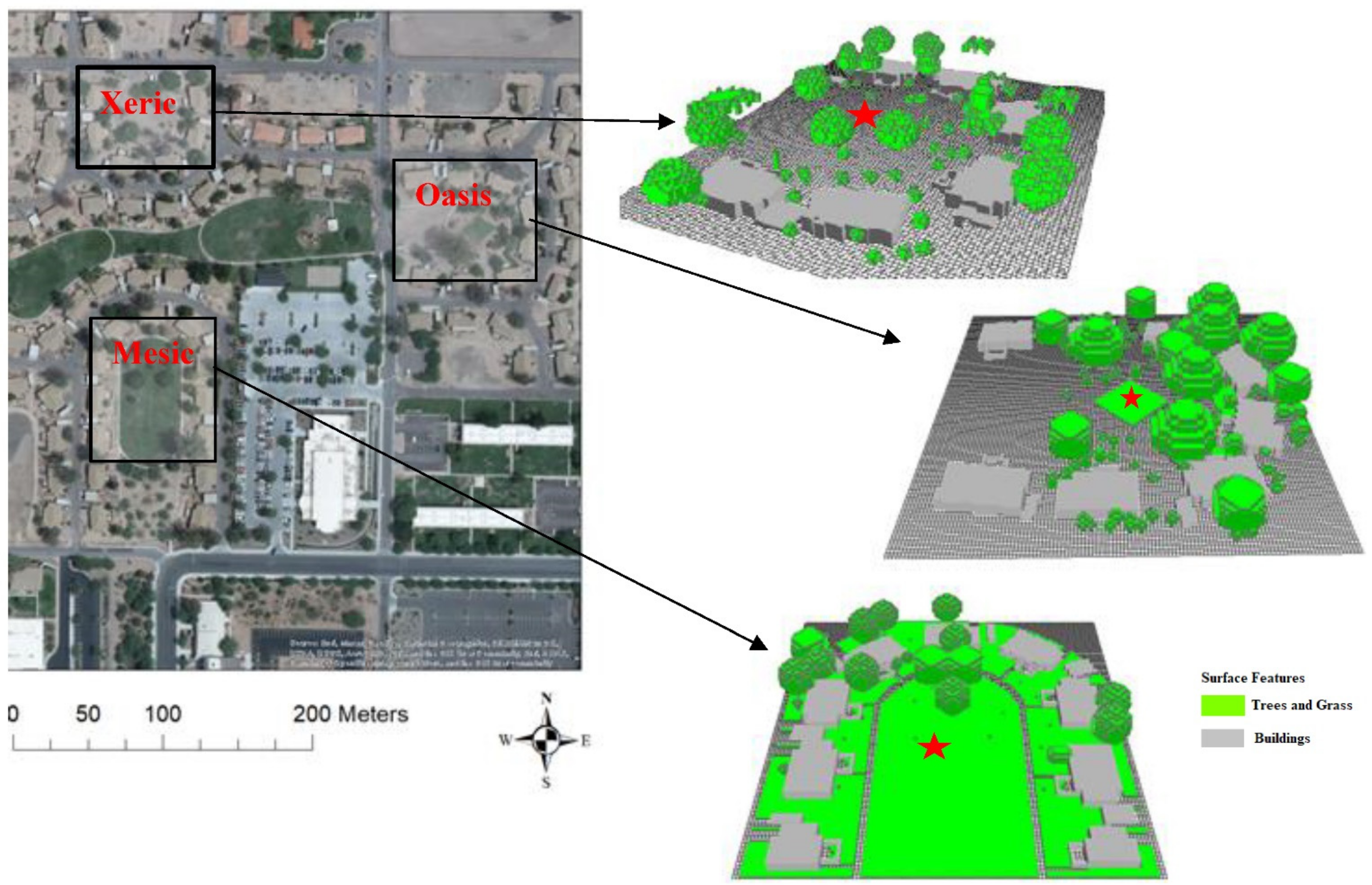
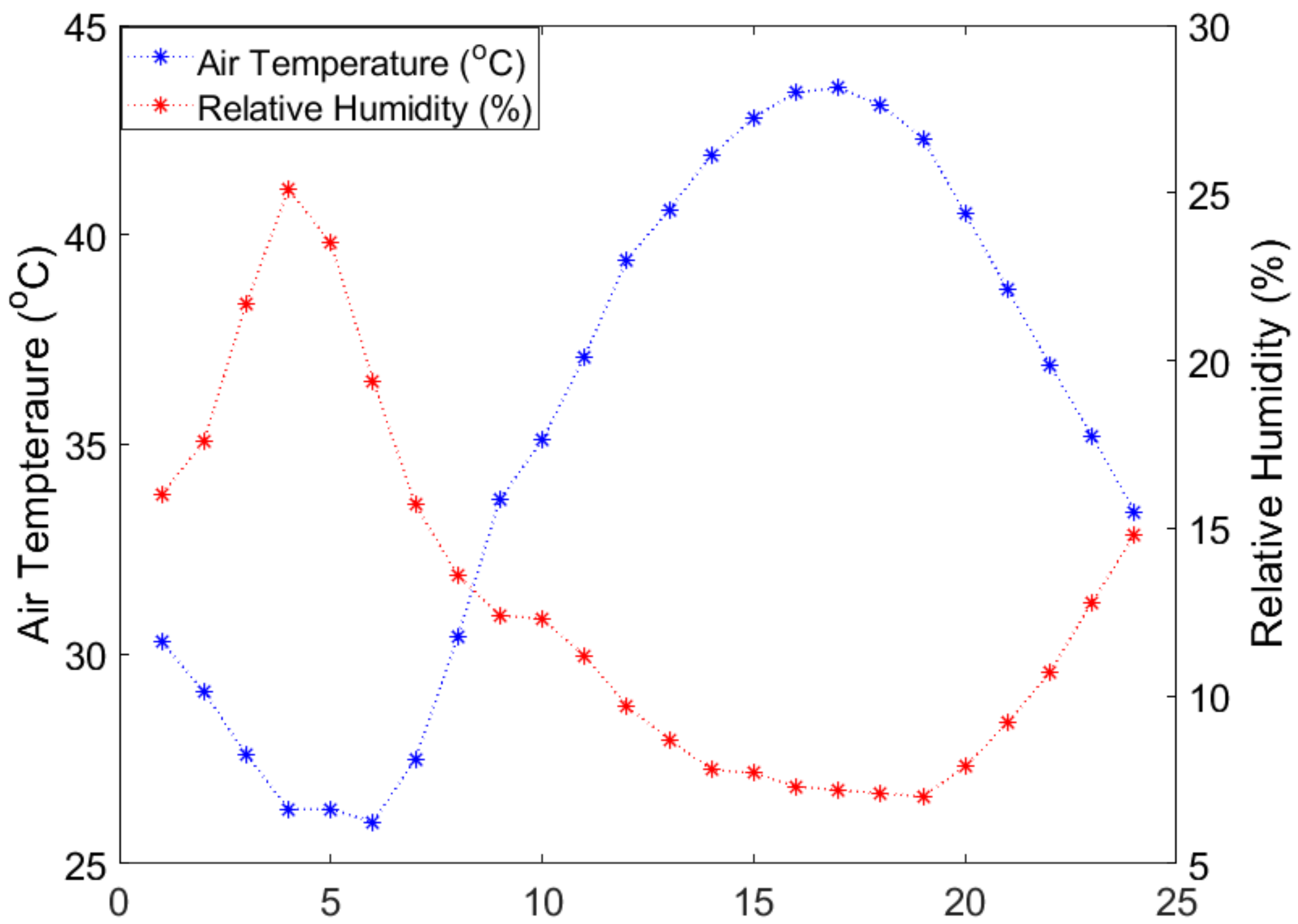
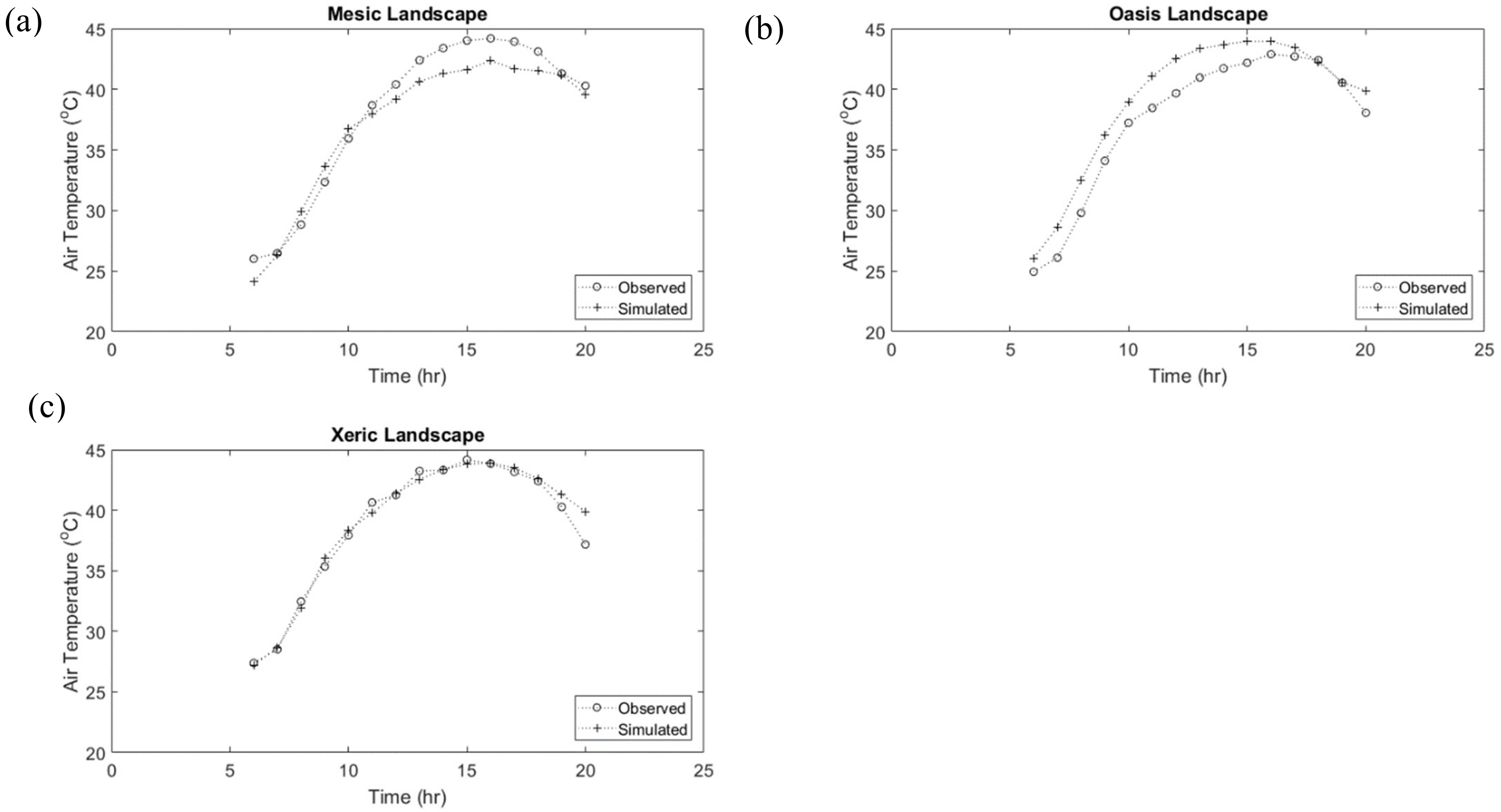


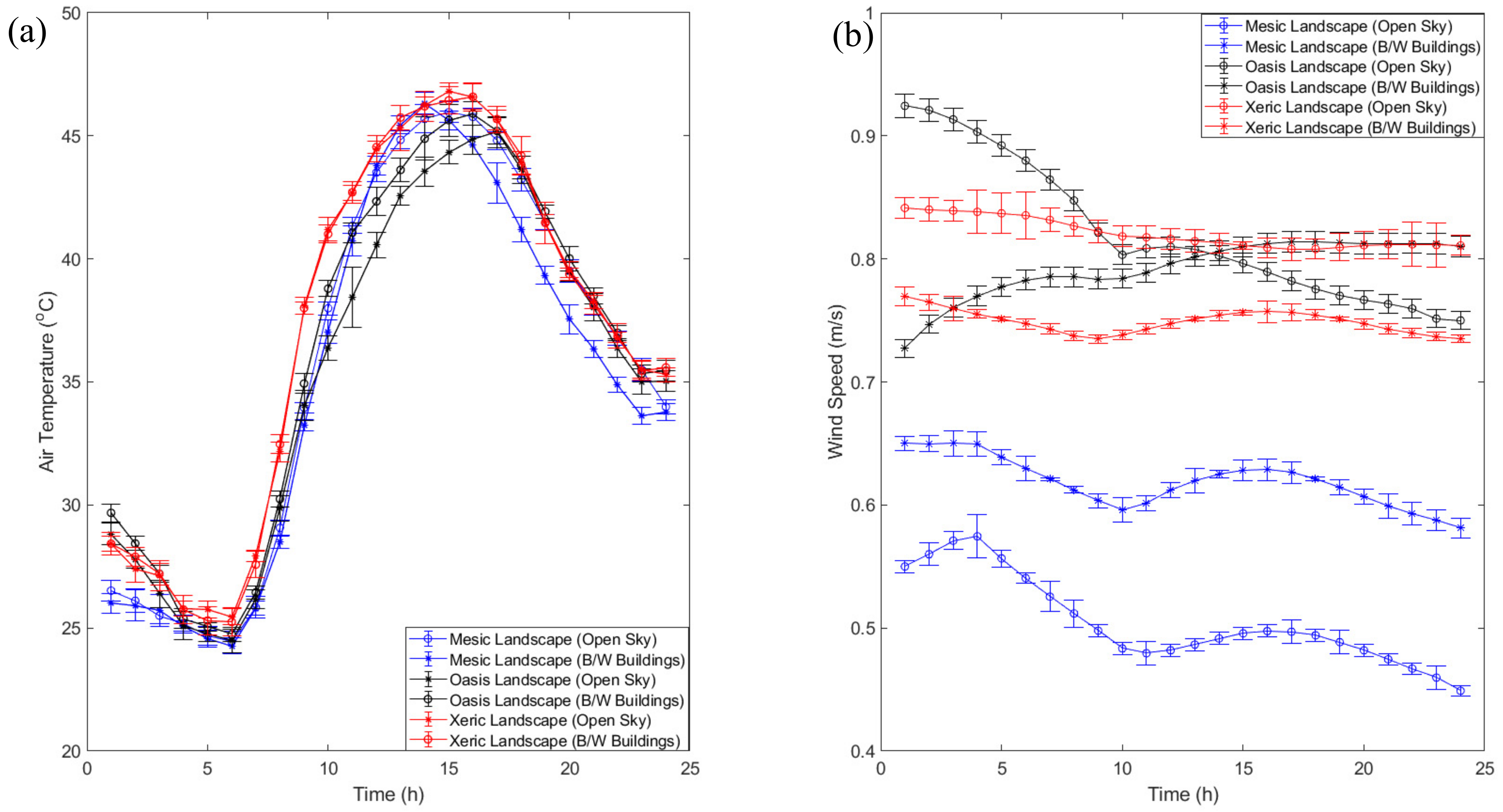
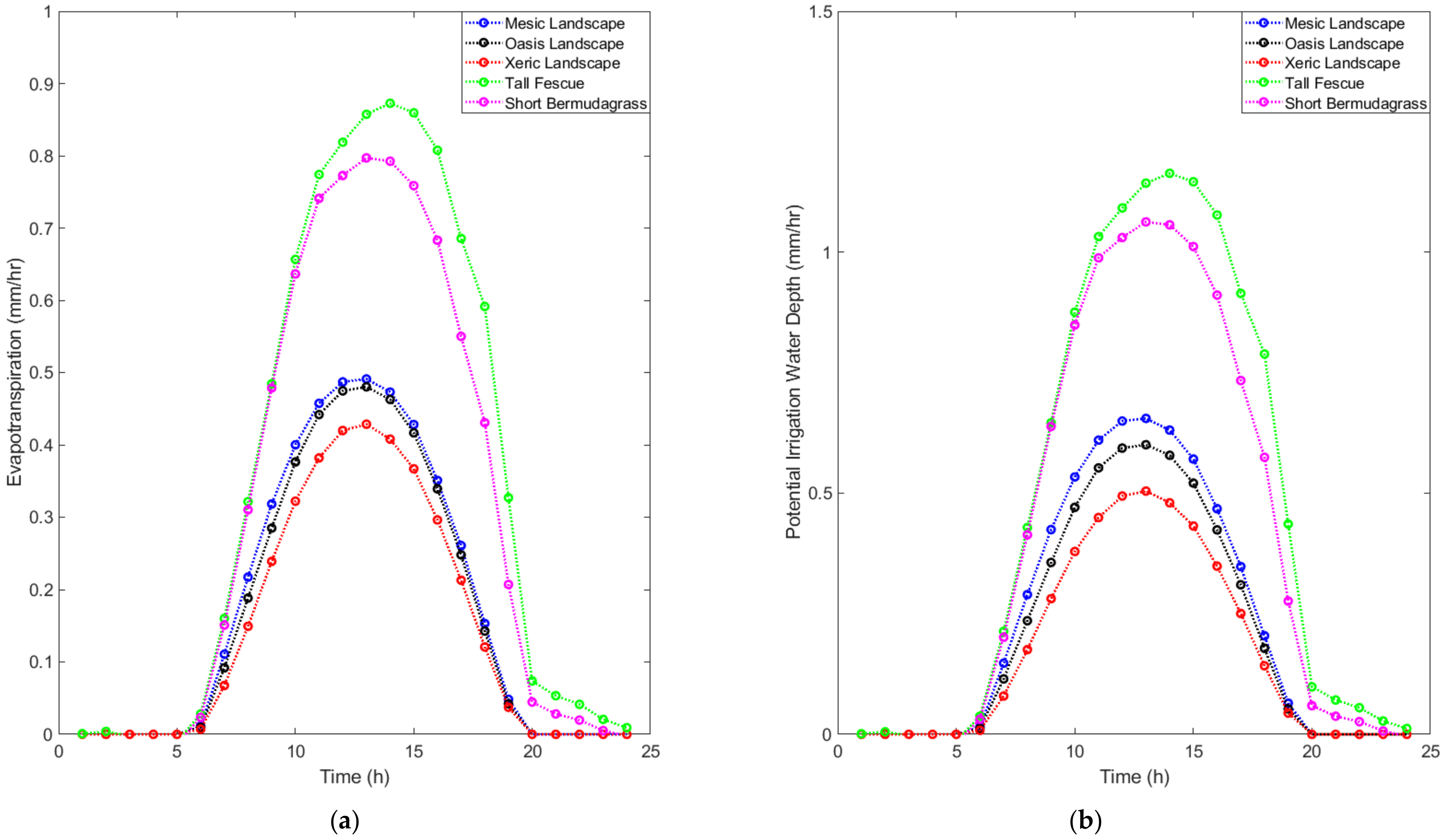
| Species Biological Name | Mesic Landscape | Oasis Landscape | Xeric Landscape |
|---|---|---|---|
| Trees | |||
| Acacia Salonica | • | ||
| Acacia stenophylla | • | • | • |
| Brachychiton populneus | • | ||
| Brahea armata | • | ||
| Corymbia papuana | • | ||
| Eucalyptus camaldulensis | • | • | |
| Eucalyptus microtheca | • | ||
| Eucalyptus polyanthemos | • | ||
| Fraxinus under | • | ||
| Fraxinus valutina | • | ||
| Malus (apple) | • | ||
| Melaleuca viminalis | • | • | • |
| Myrtus communis | • | • | |
| Parkinsonia hybrid | • | ||
| Phoenix dactylifera | • | • | • |
| Pinus eldarica | • | • | |
| Pinus halepensis | • | ||
| Pistacia chinesis | • | ||
| Platanus wrightii | • | ||
| Platycladus orientalis | • | • | • |
| Prosopis hybrid | • | ||
| Prunus cerasifera | • | ||
| Ulmus parvifolia | • | • | |
| Washingtonia filifera | • | ||
| Shrubs and Vines | |||
| Bougainvillea hybrid | • | ||
| Caesalpinia pulcherrima | • | ||
| Caesalpinia gilliesii | • | ||
| Calliandra californica | • | ||
| Carissa macrocarpa | • | ||
| Chamaerops humilis | • | ||
| Encelia farinosa | • | ||
| Hesperaloe parviflora | • | ||
| Lantana hybrid | • | ||
| Leucophyllum candidum | • | ||
| Leucophyllum frutescens | • | ||
| MacFadyena unguis-cati | • | ||
| Myrtus communis | • | • | |
| Nerium oleander | • | • | |
| Rosa hybrid | • | ||
| Ruellia brittoniana | • | ||
| Ruellia peninsularis | • | ||
| Tacoma capensis | • | ||
| Model Parameters | Mesic | Xeric | Oasis |
|---|---|---|---|
| RMSE | 1.50 | 0.86 | 1.92 |
| MBE | 0.91 | 0.21 | 1.69 |
| MAE | 1.33 | 0.56 | 1.70 |
| d | 0.98 | 1.00 | 1.00 |
Publisher’s Note: MDPI stays neutral with regard to jurisdictional claims in published maps and institutional affiliations. |
© 2022 by the authors. Licensee MDPI, Basel, Switzerland. This article is an open access article distributed under the terms and conditions of the Creative Commons Attribution (CC BY) license (https://creativecommons.org/licenses/by/4.0/).
Share and Cite
Saher, R.; Middel, A.; Stephen, H.; Ahmad, S. Assessing the Microclimate Effects and Irrigation Water Requirements of Mesic, Oasis, and Xeric Landscapes. Hydrology 2022, 9, 104. https://doi.org/10.3390/hydrology9060104
Saher R, Middel A, Stephen H, Ahmad S. Assessing the Microclimate Effects and Irrigation Water Requirements of Mesic, Oasis, and Xeric Landscapes. Hydrology. 2022; 9(6):104. https://doi.org/10.3390/hydrology9060104
Chicago/Turabian StyleSaher, Rubab, Ariane Middel, Haroon Stephen, and Sajjad Ahmad. 2022. "Assessing the Microclimate Effects and Irrigation Water Requirements of Mesic, Oasis, and Xeric Landscapes" Hydrology 9, no. 6: 104. https://doi.org/10.3390/hydrology9060104
APA StyleSaher, R., Middel, A., Stephen, H., & Ahmad, S. (2022). Assessing the Microclimate Effects and Irrigation Water Requirements of Mesic, Oasis, and Xeric Landscapes. Hydrology, 9(6), 104. https://doi.org/10.3390/hydrology9060104








